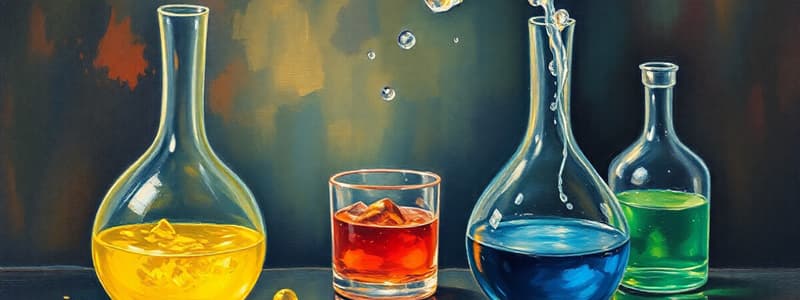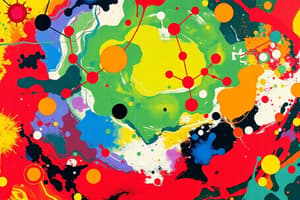Podcast
Questions and Answers
What products are formed when Na reacts with O2 according to the reactions listed?
What products are formed when Na reacts with O2 according to the reactions listed?
- Na2O3
- Na2O (correct)
- Na2O2
- NaO
Which reaction results in the formation of magnesium phosphate and water?
Which reaction results in the formation of magnesium phosphate and water?
- NaOH + H2CO3
- Na + NaNO3
- H3PO4 + KOH
- H3PO4 + Mg(OH)2 (correct)
Which of the following reactions uses an alkali metal as a reactant and produces a binary compound?
Which of the following reactions uses an alkali metal as a reactant and produces a binary compound?
- Li + AlCl3
- K + B2O3
- Na + O2
- Cs + N2 (correct)
Which of the following pairs of reactants leads to the production of sodium hydroxide and water?
Which of the following pairs of reactants leads to the production of sodium hydroxide and water?
How many products are produced in the reaction between carbon and sulfur (S8)?
How many products are produced in the reaction between carbon and sulfur (S8)?
Flashcards
Chemical Reaction
Chemical Reaction
A chemical process that involves the rearrangement of atoms and molecules, resulting in the formation of new substances. It can be represented using a chemical equation showing reactants (starting materials) and products (resulting substances).
Reactants
Reactants
The substances that undergo a chemical change during a reaction. They are found on the left side of a chemical equation.
Products
Products
The substances formed as a result of a chemical reaction. They are found on the right side of a chemical equation.
Chemical Equation
Chemical Equation
Signup and view all the flashcards
Stoichiometric Coefficient
Stoichiometric Coefficient
Signup and view all the flashcards
Study Notes
Chemical Reactions
- Reaction 1: Phosphoric acid (H3PO4) reacts with potassium hydroxide (KOH) to form potassium phosphate (K3PO4) and water (H2O).
- Reaction 2: Potassium (K) reacts with diboron trioxide (B2O3) to form potassium oxide (K2O) and boron (B).
- Reaction 3: Hydrochloric acid (HCl) reacts with sodium hydroxide (NaOH) to form sodium chloride (NaCl) and water (H2O).
- Reaction 4: Sodium (Na) reacts with sodium nitrate (NaNO3) to form sodium oxide (Na2O) and nitrogen (N2).
- Reaction 5: Carbon (C) reacts with sulfur (S8) to form carbon disulfide (CS2).
- Reaction 6: Sodium (Na) reacts with oxygen (O2) to form sodium oxide (Na2O).
- Reaction 7: Nitrogen (N2) reacts with oxygen (O2) to form dinitrogen pentoxide (N2O5).
- Reaction 8: Phosphoric acid (H3PO4) reacts with magnesium hydroxide (Mg(OH)2) to form magnesium phosphate (Mg3(PO4)2) and water (H2O).
- Reaction 9: Sodium hydroxide (NaOH) reacts with carbonic acid (H2CO3) to form sodium carbonate (Na2CO3) and water (H2O).
- Reaction 10: Potassium hydroxide (KOH) reacts with hydrobromic acid (HBr) to form potassium bromide (KBr) and water (H2O).
- Reaction 11: Sodium (Na) reacts with oxygen (O2) to form sodium oxide (Na2O).
- Reaction 12: Aluminum hydroxide (Al(OH)3) reacts with carbonic acid (H2CO3) to form aluminum carbonate (Al2(CO3)3) and water (H2O).
- Reaction 13: Aluminum (Al) reacts with sulfur (S8) to form aluminum sulfide (Al2S3).
- Reaction 14: Cesium (Cs) reacts with nitrogen (N2) to form cesium nitride (Cs3N).
- Reaction 15: Magnesium (Mg) reacts with chlorine (Cl2) to form magnesium chloride (MgCl2).
- Reaction 16: Rubidium (Rb) reacts with rubidium nitrate (RbNO3) to form rubidium oxide (Rb2O) and nitrogen (N2).
- Reaction 17: Benzene (C6H6) reacts with oxygen (O2) to form carbon dioxide (CO2) and water (H2O).
- Reaction 18: Nitrogen (N2) reacts with hydrogen (H2) to form ammonia (NH3).
- Reaction 19: Decane (C10H22) reacts with oxygen (O2) to form carbon dioxide (CO2) and water (H2O).
- Reaction 20: Aluminum hydroxide (Al(OH)3) reacts with hydrobromic acid (HBr) to form aluminum bromide (AlBr3) and water (H2O).
- Reaction 21: Butane (CH3CH2CH2CH3) reacts with oxygen (O2) to form carbon dioxide (CO2) and water (H2O).
- Reaction 22: Propane (C3H8) reacts with oxygen (O2) to form carbon dioxide (CO2) and water (H2O).
- Reaction 23: Lithium (Li) reacts with aluminum chloride (AlCl3) to form lithium chloride (LiCl) and aluminum (Al).
- Reaction 24: Ethane (C2H6) reacts with oxygen (O2) to form carbon dioxide (CO2) and water (H2O).
Studying That Suits You
Use AI to generate personalized quizzes and flashcards to suit your learning preferences.




